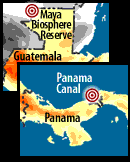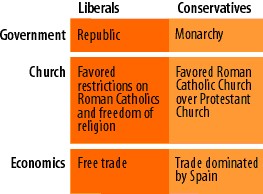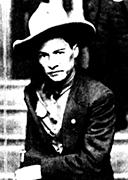|








|
 |
Pick a Region:.
. Central America

The Conquest
The Spanish conquest of Central America began around 1520. By the
middle of the 16th century, Spain established the Kingdom of Guatemala,
which was part of the Viceroyalty of New
Spain. The Kingdom of Guatemala included the future countries
of Belize, Costa Rica, El Salvador, Guatemala, Honduras, Nicaragua,
and the Mexican state of Chiapas. Panama, however, became part of
the Viceroyalty of New Granada.
Independence
The colonial period lasted from the Spanish conquest until 1821, when
the Kingdom of Guatemala declared independence from Spain. For a brief
period, these countries became part of the Mexican Empire. In 1823,
Guatemala, El Salvador, Honduras, Nicaragua, and Costa Rica formed
the United Provinces of Central America
(Britain had essentially controlled Belize since the 17th century, and Chiapas decided to stay with
Mexico). Since 1838, when, for various reasons, the United Provinces
disintegrated, these five countries have remained separate, but they
have periodically attempted to unify economically.
Liberals vs. Conservatives
One of the primary reasons the United Provinces disintegrated was
that in 1837, José Rafael Carrera, a Conservative, led a successful
revolt against the Liberals in Central America. Since it had mainly
been the Liberals who had supported the United Provinces, the Conservatives
brought an end to integration. It was the controversy between Liberals
and Conservatives that dominated the politics during most of the 19th
century. As their name suggests, Conservatives were generally resistant
to change that would threaten their favored position in society. Liberals,
on the other hand were influenced by the French Enlightenment.
One area of dispute between
Liberals and Conservatives was the type of government they favored.
Conservatives favored a monarchy, while Liberals favored a republic
with greater democracy.
Another area of dispute was the role of the
church, a very important institution in Central America. The Liberals favored greatly
reducing its wealth and political power and supported greater freedom of religion. The
Conservatives sought to maintain the Church’s privileged position.
The third area of dispute between
Conservatives and Liberals was the economy. The Liberals favored breaking up monopolies
and moving toward free trade, while the Conservatives favored the status quo, in which
trade was dominated by Spain. The struggle for power between these two groups continued
for the rest of the century.
Listed in the chart below are
the various issues the Liberals and Conservatives disagreed on and
the positions they took.

Dictators and Revolutionaries
While each Central American country has had different experiences
during the 20th century, to a great extent, the region has been characterized
by a struggle for power. In many instances, this struggle has taken
the form of revolutionary movements seeking to overthrow authoritarian
governments. In Nicaragua, the Sandinistas
overthrew Anastasio Debayle Somoza in 1979, after nearly two decades
of fighting. In similar situations, both Guatemala and El Salvador
have experienced decades of civil wars that have led to tens of thousands
of people dead or disappeared, including the well-publicized brutal
murder of six Jesuit priests in El Salvador.
United States Intervention
Not all of these struggles for power were strictly internal. In many cases, the United
States has intervened in these Central American struggles. Below are some examples of
United States intervention.
- United States Marines
stationed in Nicaragua from
1912-1933 (with exception of short period in the 1920s)
- The CIA equipped and directed a group of
Guatemalans to overthrow democratically-elected President Jacobo Arbenz of Guatemala in 1954.
- The United States trained and equipped the
Contras, a group of Nicaraguans opposed to the Nicaraguan government, during the 1980s.
- The Bush administration sent over 20,000
United States troops to Panama to remove Manuel Noriega in 1989.
In each case, the United
States was attempting to ensure that governments friendly to the United
States were in power. The specific reasons for each intervention vary.
The intervention in Guatemala (1954) and Nicaragua (1980s) were directly
related to the Cold War. In both cases,
the United States feared that the governments in these two countries
were too friendly toward the Soviet Union, and therefore, the Soviets
would gain influence in Central America. Simply put, the United States
did not want either country governed by rulers it perceived to be
friendly to the Soviets. It was feared that if the Central American
governments became communist, the rest of Latin America would become
communist, including Mexico, which borders the United States. This
chain reaction is often called the domino theory.
United States intervention in Nicaragua
(1912-1933) is more complicated than in Guatemala. Civil war in Nicaragua had thrown the
country into chaos; therefore, the United States Marines were used to stop the conflict
from spreading throughout Central America, as well as to protect the interests of United
States companies that had invested in Nicaragua. United States involvement in this case
also served as a way to ensure the United States controlled the rights to any attempts to
build a canal through Nicaragua. In turn, the Germans and Japanese, who had been
considering plans to dig a canal through Nicaragua, were now prevented from doing so.
The reasons for United States intervention in
Panama are somewhat debatable. Some of the contributing factors were Manuel Noriega’s
cancellation of elections that appeared to have been won by an opposing political party,
his involvement in the drug trade, and his uncooperativeness with the United States (even
though he used to be a part-time employee of the CIA).
 In
each of the interventions above, the people's reactions in the country
are mixed. For instance, in Nicaragua (1912-1933), those individuals
who shared United States interests (political and economic stability)
generally appreciated United States involvement. On the other hand,
foreign intervention by any country always arouses the anger of a
significant group of people. In the Nicaraguan case, the most visible
opponent to United States intervention was Augusto César Sandino.
In the late 1920s he started a rebel movement in Nicaragua that fought
against United States involvement. His name would eventually be adopted
by the Sandinistas later in the century. Photo:
General Sandino Photo © 1999 -www.arttoday.com In
each of the interventions above, the people's reactions in the country
are mixed. For instance, in Nicaragua (1912-1933), those individuals
who shared United States interests (political and economic stability)
generally appreciated United States involvement. On the other hand,
foreign intervention by any country always arouses the anger of a
significant group of people. In the Nicaraguan case, the most visible
opponent to United States intervention was Augusto César Sandino.
In the late 1920s he started a rebel movement in Nicaragua that fought
against United States involvement. His name would eventually be adopted
by the Sandinistas later in the century. Photo:
General Sandino Photo © 1999 -www.arttoday.com
Peace in the Region
Conflict is not the only political characteristic of Central America this century. Costa
Rica has enjoyed peace and relative prosperity, especially during the last half of the
20th century. In the late 1940s, Costa Rica abolished its military and achieved an
admirable economic system. In 1987 Costa Rican president Oscar Arias Sánchez proposed the
peace process that led to the Central American presidents signing the Central American
Peace Accord. President Arias won the Nobel Peace Prize for his efforts in this peace process.
The 1990s
In El Salvador and Guatemala, peace agreements have been signed between the groups at war,
and human rights commissions have been established. The commissions have attempted to shed
light on the human rights violations during the wars in these countries in order to begin
the process of healing and reconciliation. One of the tough questions these countries have
had to sort out is, What should be done with individuals who violated human rights during
the wars by committing gruesome acts of torture or by participating in "death
squads"?
Since the militaries in these countries were
responsible for a great amount of these human rights violations and these militaries are
still very powerful, it has been difficult for the government to prosecute these
criminals. On the other hand, if the human rights violators are not prosecuted, it is
difficult to argue that justice has been served. These issues are not easy to resolve, but
they must be for peace in the region. Nevertheless, the 1990s have been promising with
respect to ending the raging conflicts in Central America. |
 |



    
|

